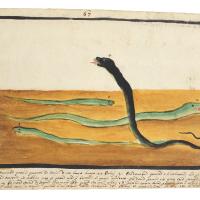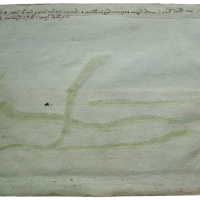PW067: Snakes called muamba . . . emdamba . . . nbambi
1: Serpe d:o Muamba1 grossa quanto la coscia di un homo lunga 25: Palmi 2: Emdamba questa e si velenosa che percotendola con qualche bastone; se subbito non si getta via il bastone si more av[v]elenato;2 ne deve parere cio gran cosa perche nelle parti di Sonzo3 vi ha una sorte di serpe chiamata Po. quale sta nelli alberi e p[er] restare morto basta passare sotto l’albore stesso; 3: Nbambi altra sorte di serpe; questa e del colore della corteccia dei Albori et avinchiandosi ad essi non si distinque e però [verso] piu pericolosa4 4: cobra Preta questa e la piu usuale; e molte se ne amazano anche dentro le case della Città, il suo spino diseccato e ottimo p[er] la scazanzia e per t[u]tti i mali della gola
1: Snake called Muamba as big as the thigh of a man 25: Palms long 2: Emdamba this one is so venemous that if having hit it with a [walking] stick; if the one does not get rid of the stick one dies poisoned; this must not seem a great thing because in the region of Sonzo there is a type of snake called Po which stays in the trees and to end up dead it suffices to walk under the tree itself; 3: nbambi other type of snake; this one is the color of tree bark and approaching it one does not distinguish it it is however [verso] very dangerous 4: Black snake that is the most common; and many are killed even inside the houses of the City; its dried spine is very good for sore throat and for all the ailments of the throat
- 1Cavazzi writes “MVAMBA, grossa quanto la coscia di un’huomo, lunga 30. Palmi, inghiottisce la Ndamba.” Here the exact same wording is used in both works, with a further exaggeration in the size in the Istorica Descrizione. Cavazzi and Alamandini, Istorica descrizione, 47.
- 2Cavazzi and Alamandini, Istorica descrizione, 47. Ndamba in Cavazzi, with the same cane anecdote.
- 3An alternative orthography for Nzonzo according to François Bontinck. See Luca da Caltanisetta and François Bontinck, Diaire congolais. 1690-1701, vol. 27, Publications de l'Université Lovanium de Kinshasa (Louvain, Paris: Éditions Nauwelaerts; Béatrice-Nauwelaerts, 1970), li. It was at the time of Luca da Caltanisetta (1690-1701) “a settlement situated east of the Inkisi River at a distance of eight walking days from Mbanza Nsundi” according to Bernard Clist et al., “The Elusive Archaeology of Kongo Urbanism: the Case of Kindoki, Mbanza Nsundi (Lower Congo, DRC),” African Archaeological Review 32, no. 3 (2015): 369-412.
- 4Cavazzi and Alamandini, Istorica descrizione, 47. Same anecdote about being difficult to notice because of its bark color.




Add new comment